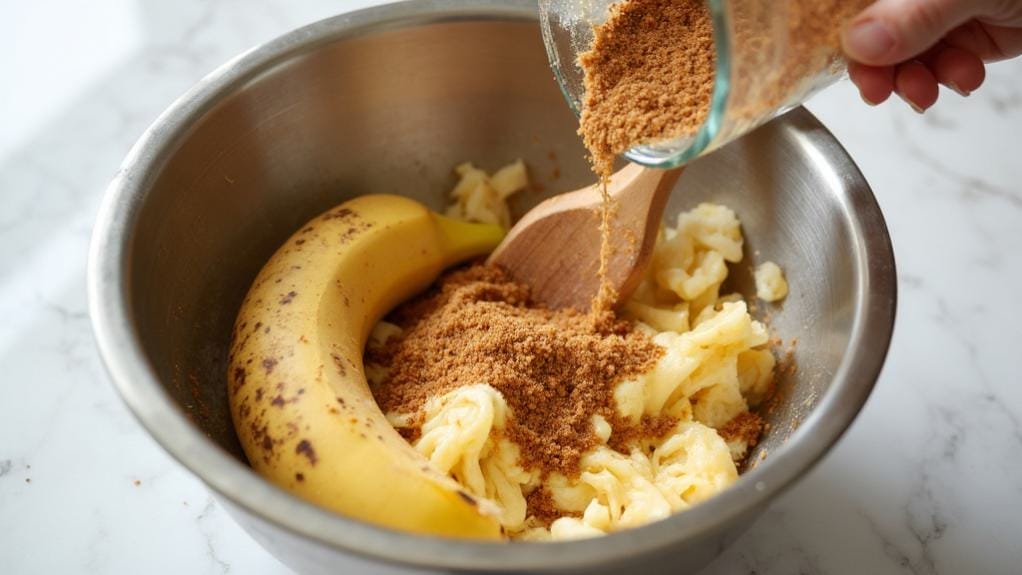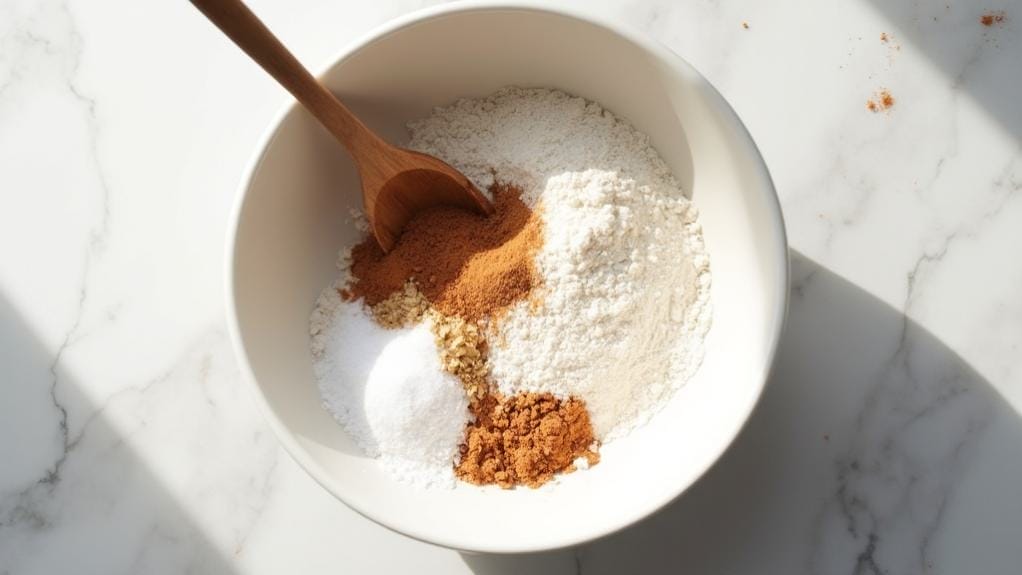I’ve discovered that traditional fruitcake‘s notorious reputation disappears entirely when reimagined as a vegan creation. As someone who’s spent years perfecting plant-based versions of classic desserts, I’m continually amazed by how mashed bananas and coconut oil create a richness that rivals conventional butter-laden recipes.
The secret lies in understanding how each ingredient contributes to the cake’s structure – from the binding properties of ground flaxseed to the moisture-retaining qualities of dried fruits. If you’re curious about how these elements work together to create something truly special, there’s an interesting scientific principle at play.
Recipe
A vegan fruitcake offers all the nostalgic holiday flavors without any animal products, making it perfect for plant-based celebrations. This rich, dense cake combines sweet dried fruits and crunchy nuts with warm seasonal spices, creating a festive dessert that rivals its traditional counterpart.
The secret to this recipe’s success lies in using natural plant-based ingredients that provide moisture and binding properties. Mashed bananas and applesauce work together to create the perfect texture, while coconut oil adds richness. The result is a moist, flavorful cake that will satisfy both vegans and non-vegans alike.
- 2 cups all-purpose flour
- 1 cup mashed ripe bananas
- 1/2 cup applesauce
- 1/2 cup melted coconut oil
- 1 cup brown sugar
- 1 cup mixed dried fruits (raisins, cranberries, apricots)
- 1/2 cup chopped nuts
- 1 teaspoon baking soda
- 1 teaspoon cinnamon
- 1/2 teaspoon nutmeg
- 1/4 teaspoon salt
- 2 tablespoons orange juice
- 1 teaspoon vanilla extract
Preheat oven to 350°F (175°C) and line a 9-inch loaf pan with parchment paper. In a large bowl, whisk together flour, baking soda, cinnamon, nutmeg, and salt.
In a separate bowl, combine mashed bananas, applesauce, melted coconut oil, brown sugar, orange juice, and vanilla extract. Mix wet ingredients into dry ingredients until just combined, then fold in dried fruits and nuts.
Pour batter into prepared pan and bake for 60-70 minutes, or until a toothpick inserted into the center comes out clean. Cool completely before slicing.
For optimal results, soak the dried fruits in orange juice overnight before baking. If the top of the cake starts browning too quickly, cover with aluminum foil while baking.
Store the cake in an airtight container at room temperature for up to one week, or freeze for up to three months. The flavor actually improves after a day or two, making this an excellent make-ahead dessert.
Step-By-Step Cooking Instructions
You’ll begin your vegan fruitcake journey by creaming together the mashed bananas and brown sugar in a large bowl, while separately whisking the flour, spices, baking soda, and salt in another bowl.
Next, you’ll incorporate the melted coconut oil and orange juice into the banana mixture, ensuring everything is well combined.
Finally, you’ll gently fold the dry ingredients into the wet mixture, taking care to add the pre-soaked dried fruits and nuts last, creating a beautifully textured batter that’s ready for baking.
Step 1. Combine Bananas and Sugar

Begin by thoroughly mashing the ripe bananas in a large mixing bowl until they reach a smooth, creamy consistency with minimal lumps.
You’ll want to use bananas that are well-ripened with dark spots on the peel, as these offer the best natural sweetness and moisture for your vegan fruitcake. Using a fork or potato masher, press and stir until you’ve achieved a uniform texture.
Add the brown sugar to your mashed bananas and blend them together using a wooden spoon or electric mixer on medium speed.
You’ll notice the mixture becoming more fluid as the sugar begins to dissolve into the banana puree. Continue mixing for about 2-3 minutes until the sugar is fully incorporated and the mixture takes on a slightly caramel-like appearance.
This step is crucial for developing the cake’s rich flavor profile and ensuring proper binding of ingredients. If you’re using an electric mixer, scrape down the sides of the bowl occasionally to guarantee all the sugar gets thoroughly combined with the banana mixture.
Step 2. Mix Dry Ingredients Separately

While your banana-sugar mixture rests, gathering the dry components for your vegan fruitcake sets the stage for a perfectly balanced texture.
In a large mixing bowl, start by sifting the 2 cups of all-purpose flour to remove any lumps and incorporate air, which will help create a lighter crumb in your final cake.
Add the baking soda, which will react with the acidic components to provide necessary lift, then measure in your warming spices – the cinnamon and nutmeg – along with the salt.
You’ll want to use a whisk to thoroughly combine these ingredients, ensuring even distribution throughout the flour.
Don’t skip this step, as proper mixing now prevents unwanted pockets of spice or salt in your finished cake.
If you’re working in a humid environment, you might notice the flour feeling slightly damp.
That’s perfectly normal, but you’ll want to work quickly once you’ve mixed the dry ingredients.
Set this bowl aside, keeping it away from any moisture or heat sources until you’re ready to combine it with your wet ingredients in the next step.
Step 3. Add Melted Coconut Oil

The next crucial step brings silky-smooth melted coconut oil into your fruitcake mixture.
You’ll want to ensure your coconut oil is completely melted but not too hot – it should be just warm to the touch, around 76°F (24°C). If it’s too hot, let it cool slightly before proceeding to prevent any adverse reactions with your other ingredients.
Pour the 1/2 cup of melted coconut oil in a steady stream into your wet ingredient bowl, whisking continuously as you add it.
You’ll notice the mixture becoming smoother and more emulsified with each turn of your whisk. The coconut oil serves as your vegan butter substitute, providing the essential fat content that’ll give your fruitcake its characteristic rich texture and help keep it moist during baking.
Don’t worry if you see small spots of coconut oil floating on top – this is normal and will incorporate fully once you combine your wet and dry ingredients.
If your other wet ingredients are cold, you might notice the coconut oil starting to solidify; simply warm the mixture slightly by placing the bowl in a warm water bath for a minute or two, then whisk again until smooth.
Step 4. Stir in Orange Juice

Having prepared your wet ingredients, now’s the time to add 2 tablespoons of fresh orange juice to the mixture. Pour the juice slowly while stirring continuously to ensure it integrates evenly throughout your batter.
You’ll notice the orange juice immediately brightens both the aroma and the color of your mixture, adding a subtle citrus note that’ll enhance the overall flavor profile of your fruitcake.
If you’ve followed the optional step of soaking your dried fruits in orange juice overnight, you’ll want to drain them thoroughly before adding them to the batter, but don’t discard that precious soaking liquid.
Instead, you can substitute it for the fresh orange juice called for in this step, as it’s now infused with the natural sweetness of the dried fruits. The juice serves multiple purposes in this vegan recipe – it acts as a binding agent, adds moisture, and provides natural acidity that helps activate the baking soda.
As you stir, you’ll see the batter become slightly looser and more cohesive, creating the perfect consistency for a moist, flavorful fruitcake.
Step 5. Fold in Fruits Carefully

Once your batter has reached the perfect consistency, it’s time for the delicate process of incorporating your dried fruits and nuts. Using a large rubber spatula, sprinkle one-third of your fruit mixture over the batter and use gentle, sweeping motions to fold it in from the bottom up. This technique helps prevent the fruits from sinking to the bottom during baking.
Continue adding the remaining fruits in two more batches, maintaining a light touch as you fold. You’ll want to preserve the air bubbles that have developed in your batter while ensuring the fruits are evenly distributed. Pay special attention to scraping the bottom of the bowl, where dry ingredients often hide.
When you notice streaks of fruit throughout the batter and no large clumps remain, you’ve achieved the ideal incorporation. Don’t overmix – a few gentle strokes should do the trick.
The finished batter should look marbled with fruits and nuts, creating an appetizing preview of your finished fruitcake. You’re now ready to transfer this carefully crafted mixture to your prepared loaf pan.
Why I Love This Dish
My passion for this vegan fruitcake stems from its remarkable ability to capture all the nostalgic holiday flavors I cherished growing up, while aligning perfectly with my plant-based lifestyle.
What I find most enchanting is how the natural sweetness of mashed bananas and applesauce creates a moist, tender crumb that rivals traditional versions made with eggs and butter.
I’m particularly drawn to the way the dried fruits, especially when soaked overnight in orange juice, contribute bursts of concentrated flavor throughout each slice.
The aromatics of cinnamon and nutmeg transport me back to my grandmother’s kitchen, yet I’ve discovered that coconut oil adds its own subtle depth that makes this version uniquely special.
What makes me proudest about this recipe is its power to unite everyone at the table, regardless of their dietary preferences.
I’ve served it countless times at holiday gatherings, and it never fails to surprise skeptics who can’t believe it’s completely plant-based.
The recipe’s versatility also lets me experiment with different dried fruit combinations, making each batch a new adventure in flavor exploration.

Leave a Reply